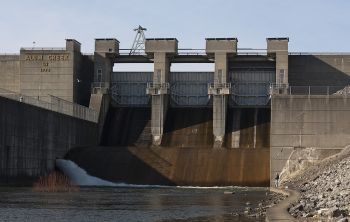Pipe Flow

|
| The Alum Creek Dam Spillway's Low Flow Control Pipe, used for daily operation, can be seen open flowing into Alum Creek.
(Image Source: Wikimedia) |
The primary objective of pipe flow in dams is to convey water efficiently and reliably from one location to another within the dam structure. Pipes are used to transport water from the reservoir to various outlets, such as turbine intakes for hydropower generation or downstream release points. The goal is to ensure the smooth and controlled movement of water, minimizing energy losses, and maximizing flow rates. Pipe flow is designed to facilitate water distribution, drainage, or controlled discharge to meet operational and management requirements.
Pipe flow in dams exhibits unique characteristics influenced by parameters such as pipe diameter, length, roughness, and flow velocity. The flow can be categorized as either laminar or turbulent, depending on the Reynolds number, which represents the ratio of inertia forces to viscous forces in the flow. Laminar flow is smooth and orderly, while turbulent flow is chaotic and characterized by eddies and fluctuations. Understanding these characteristics is crucial for designing pipes that ensure efficient water conveyance and minimize energy losses.
Various calculation methods are used to analyze and determine the characteristics of pipe flow in dams. The most common approach is the application of the principles of fluid mechanics, such as Bernoulli's equation, which relates the velocity, pressure, and elevation of the flowing water. Other equations, such as the Darcy-Weisbach equation or the Manning's equation, can be employed to calculate flow rates, head losses, and hydraulic gradients in the pipes. These calculations, combined with considerations of pipe material, slope, and operational constraints, aid in designing pipes to achieve efficient water conveyance.
Efficient pipe design is critical for the effective operation and management of dams. Proper pipe sizing, material selection, and layout optimization are essential to minimize head losses, frictional resistance, and energy consumption. The design should account for factors such as pipe roughness, flow velocities, and potential sedimentation or blockages. Effective pipe design also considers the potential for water hammer, a transient pressure surge that can occur due to sudden changes in flow or valve operations. By optimizing pipe design, engineers can ensure efficient water conveyance, reduce operational costs, and maximize the utilization of water resources.
Pipe flow in dams requires careful consideration of safety and operational aspects. Engineers must design pipes to withstand the hydraulic forces and potential water hammer effects associated with the flow. Adequate control mechanisms, such as valves or gates, should be implemented to regulate flow rates and ensure safe operation. Regular inspection and maintenance of pipes are essential to detect any corrosion, leaks, or blockages that may affect performance. Effective communication and coordination among dam operators, maintenance personnel, and downstream stakeholders are crucial for managing pipe flow and responding to any potential issues or emergencies.
